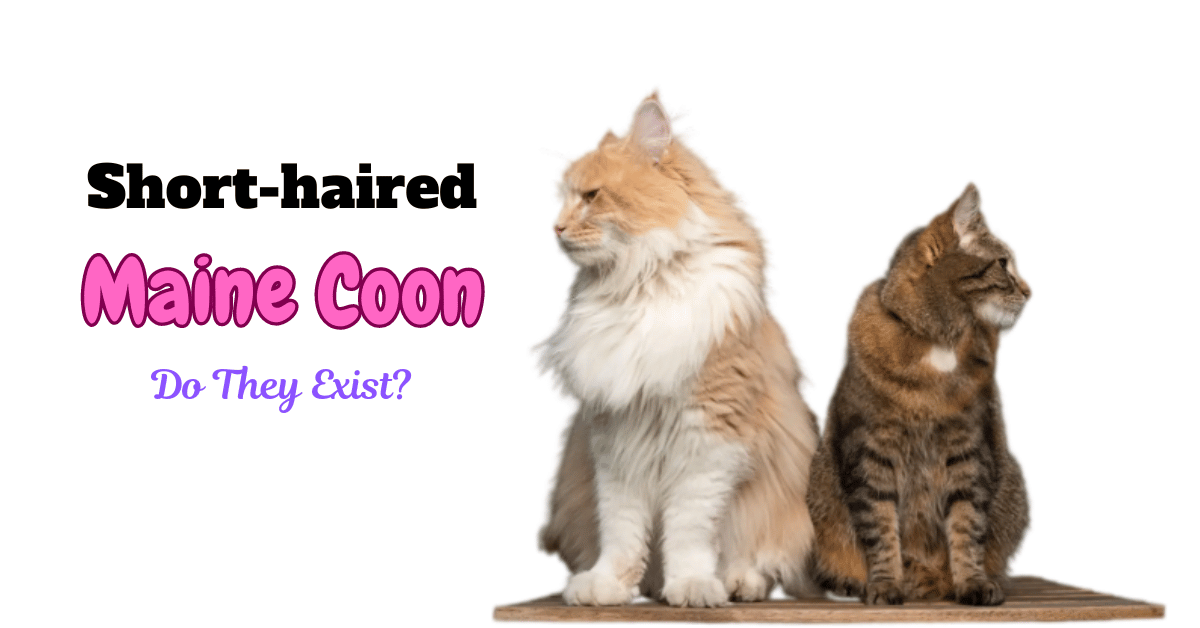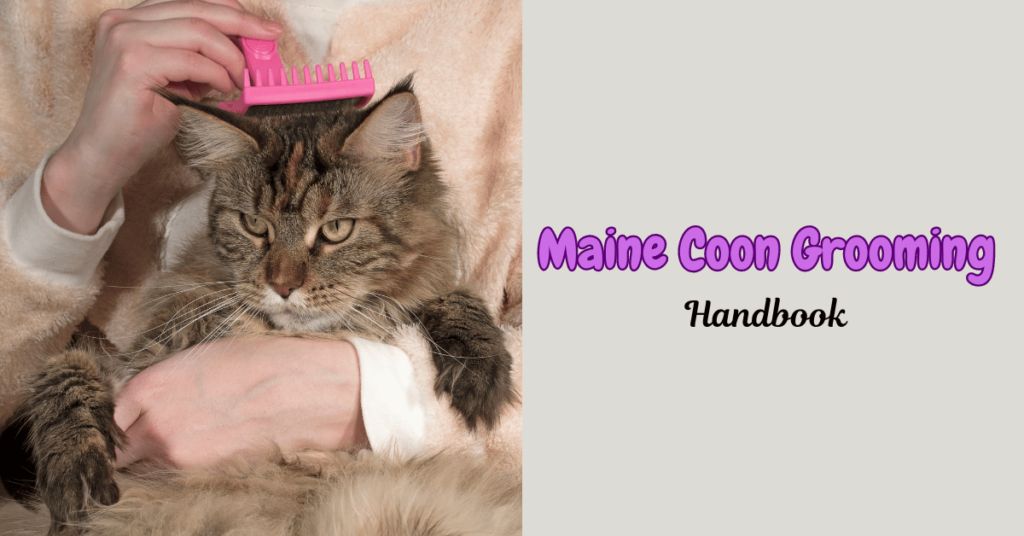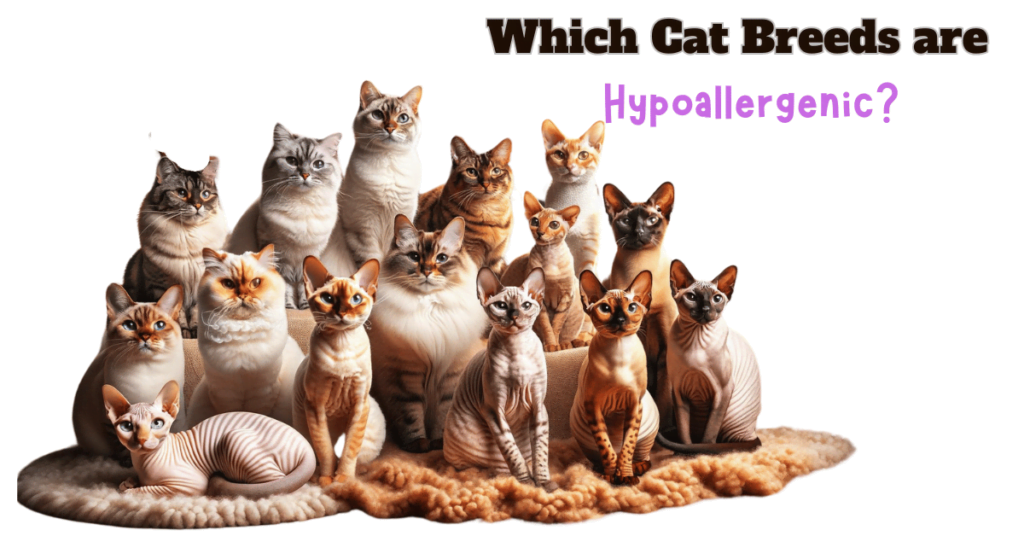This post contains affiliate links and I will be compensated if you make a purchase after clicking on my links.
Exploring the Diversity of Short-Haired Maine Coons
Maine Coons, the gentle giants of the cat universe, are typically celebrated for their regal long fur and impressive stature. However, there are indeed short-haired Maine Coons, each with their own unique traits.
In this guide, we’ll explore the fascinating world of these less commonly fluffy variants, discovering the diverse characteristics that make each one distinct.
Origins and Genetics of Short-Haired Maine Coons
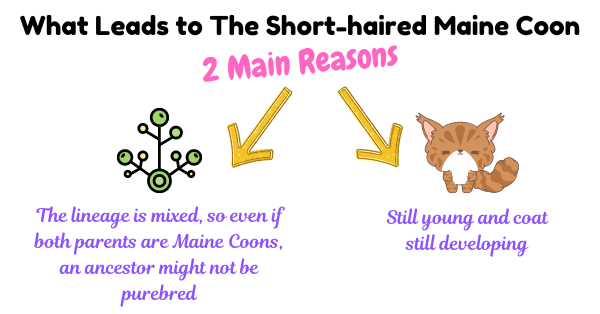
If you encounter a Maine Coon with shorter hair, it’s likely that the cat’s lineage includes a mix—indicating a Maine Coon mix. Although they come in all shapes and colors, a true-blue purebred Maine Coon will typically flaunt a long coat.
Another possibility for encountering a short-haired Maine Coon is if it’s a young kitten. It’s not unusual to see a ‘shorthair’ Maine Coon kitten simply because their coats and manes start growing in fully at an older age
For those who fancy the size and presence of a Maine Coon but perhaps not the full fur load, finding a short-haired variant could be the answer. These cats may inherit the body and heart of a Maine Coon but carry the hair genes of another breed, thanks to one of their parents.
Characterizing the Purebred Maine Coon
1. Size and Stature
Maine Coons tower over the feline world, with adult males typically weighing 15 to 25 pounds and females a tad lighter. Their muscular bodies and long frames give them an imposing, regal presence.
2. Maine Coon’s Coat
Their iconic coats are long, dense, and water-resistant, with a heavier mane resembling a lion’s and a plume-like bushy tail perfect for snuggling into warmth. The fur is shorter on the head and shoulders, growing longer on the stomach and flanks. Maine Coon kittens typically have thinner fur for the first 4 to 6 months.
Their ear tufts begin to develop around 2 to 3 months old, and the lion-like plumes around the neck start to become prominent by 9 months. However, the full majesty of their mane and coat continues to thicken and lengthen as they grow, often not reaching its full glory until they are about two to four years old.
Fact: This breed’s fur isn’t just ornamental; it’s essential for surviving Maine’s harsh winters, where temperatures can drop to 15°F, especially in the northern regions.
3. Facial Features
With large, expressive eyes and tufted ears resembling a lynx’s, Maine Coons have a look of nobility. Their broad cheekbones and wide-set eyes enhance their majestic and wise appearance.
4. Colors and Patterns
The Maine Coon palette includes almost every cat color and pattern imaginable, from classic tabbies to sophisticated solids and everything in between. They flaunt colors like black, white, brown, silver, blue, and red, with patterns including solid, tortoiseshell, tabby, mackerel, smoke, and ticked.
5. Personality
Maine Coons are the teddy bears of the cat world—friendly, sociable, and intelligent. Their dog-like loyalty and playful antics make them wonderful companions who can even learn tricks like fetching or leash walking.
6. Grooming Needs
Despite their luxurious fur, Maine Coons are prone to matting if not regularly groomed. Regular brushing is essential to maintain their coat’s appearance and to prevent matting. The entire body, including under the legs and belly, should ideally be brushed daily, or at least two to three times a week.
Exploring the Short-Haired Maine Coon
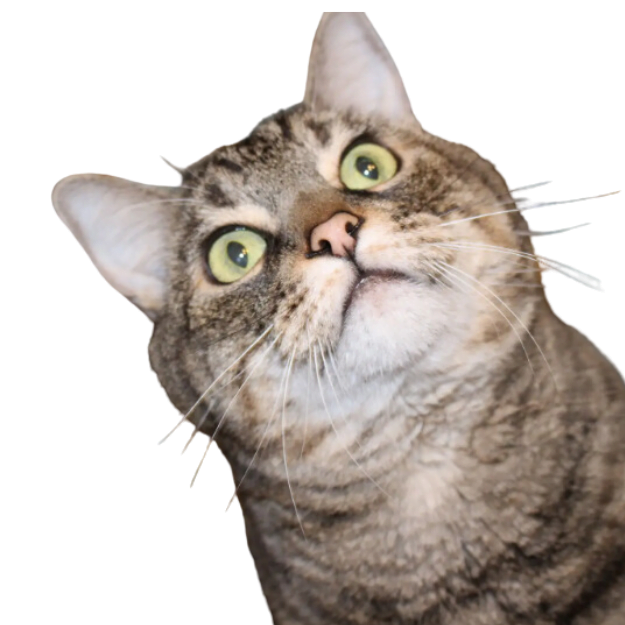
Short-haired Maine Coons typically result from crossbreeding a purebred Maine Coon with another shorter-haired breed, such as the American Shorthair, Scottish Fold or the British Shorthair. These mixes combine the robust size and build of the Maine Coon with the shorter coat of their other breed parent, leading to various unique appearances.
Size and Build
Despite the shorter coat, these cats retain the large stature characteristic of the Maine Coon breed. They can weigh anywhere from 9 to 20 pounds and stand up to 16 inches at the shoulder, making them still quite the gentle giants.
Fur Characteristics and Variability
Crossbreeds can display an exciting array of coat lengths and textures. While some kittens might inherit the medium-length fur of an Short-haired parent, others may exhibit the longer, shaggier coat typical of the Maine Coon. It’s not uncommon to see a Maine Coon mix with a dramatic lion’s mane around the neck and shorter hair elsewhere, illustrating the unpredictable nature of genetic inheritance.
However, in most cases, their coat requires less grooming and is less prone to matting. A regular brushing once or twice a week is usually enough to keep their coat in top shape. Even with shorter hair, Maine Coons still shed, so regular brushing helps minimize fur around the house.
Tip: For short-haired Maine Coons, soft bristle brushes are the go-to choice to keep their skin happy and scratch-free.
Color and Pattern Diversity
These mixes also inherit a rich palette of colors and patterns from both parent breeds. The potential combinations are vast, ranging from the solid shades of a British Shorthair to the intricate tabby patterns often seen in Maine Coons.
Personality Traits
Personality-wise, short-haired Maine Coon mixes tend to inherit the best traits from both breeds. Whether more akin to the Maine Coon or their shorthaired counterpart, these cats generally display a wonderful disposition.
They are often sociable, intelligent, and adaptable, fitting well into various family environments. The influence of American Shorthair, British Shorthair, or any other shorthaired breed can bring slight variations to their behavior, but these mixes usually maintain a lovable, engaging nature.
The Risks of Shaving a Maine Coon to Achieve a Short-Haired Look
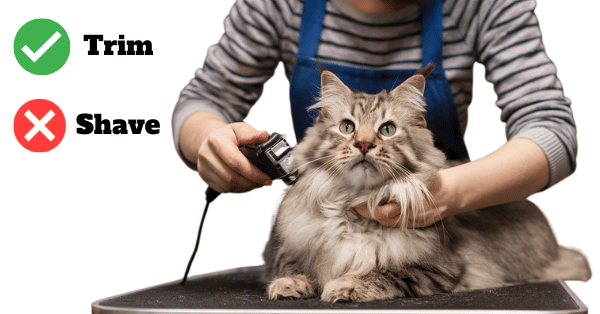
If you’re dreaming of a short-haired Maine Coon, you might wonder if shaving down their lush coat is a viable option. However, while it might be tempting to try for a less fluffy appearance, shaving a Maine Coon is generally not recommended.
Why Shaving Isn’t the Answer
Maine Coons are adorned with a thick, multi-layered coat that serves several critical functions. This fur isn’t just for show; it helps regulate their body temperature across different seasons, providing essential insulation against both cold and heat.
By shaving off this natural protective layer, you’re exposing your Maine Coon to potential harm. Vulnerabilities like sunburn, insect bites, and extreme temperatures can pose significant health risks to a shaved Maine Coon.
Moreover, the coat of a Maine Coon contributes to their overall sense of security and comfort. Removing it can lead to stress and anxiety, which in turn may affect their behavior and even make them dread grooming sessions in the future. The psychological impact should not be underestimated, as the comfort provided by their fur is akin to a built-in security blanket.
Alternatives to Shaving
Rather than shaving, consider regular grooming to manage your Maine Coon’s fur. Routine brushing and quarterly trimming can effectively control matting and reduce shedding, without compromising their health or comfort. For those specifically seeking a short-haired look, adopting a naturally short-haired breed or a Maine Coon mix, as previously discussed, might be a better fit for your preferences.
Understanding Your Options: Short-Haired Maine Coons
In exploring the short-haired Maine Coon, it’s crucial to pinpoint the reasons behind your preference for this less common variant. If a Maine Coon with a shorter coat appeals to you, understanding that a genuine short-haired Maine Coon typically comes from a mixed lineage is essential.
These mixed-breed cats often retain the beloved characteristics of the Maine Coon, including their size and engaging personality, with the added benefit of potentially lighter grooming requirements. Ultimately, whether purebred or mixed, Maine Coons bring immense joy and companionship.
Meet Sean, a fintech whiz with a penchant for pet purrs and blockchain buzz. After a decade of fintech feats, Sean’s tech talents leaped from ledger lines to litter lines, driven by a passion for pets and a vision for a more connected pet care community. With three critter companions as co-pilots, Sean launched this blog to share a treasury of pet-friendly tech tips and tales.

